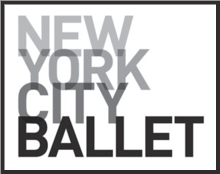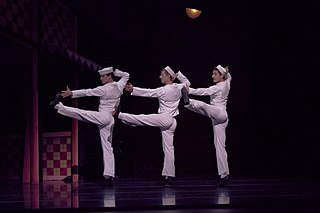
New York City Ballet (NYCB) is a ballet company founded in 1948 by choreographer George Balanchine and Lincoln Kirstein. Balanchine and Jerome Robbins are considered the founding choreographers of the company. Léon Barzin was the company's first music director. City Ballet grew out of earlier troupes: the Producing Company of the School of American Ballet, 1934; the American Ballet, 1935, and Ballet Caravan, 1936, which merged into American Ballet Caravan, 1941; and directly from the Ballet Society, 1946.
Le Baiser de la fée is a neoclassical ballet in one act and four scenes composed by Igor Stravinsky in 1928 and revised in 1950 for George Balanchine and the New York City Ballet. Based on Hans Christian Andersen's short story Isjomfruen, the work is an homage to Pyotr Ilyich Tchaikovsky, for the 35th anniversary of the composer's death. Stravinsky elaborated several melodies from early piano pieces and songs by Tchaikovsky in his score. A commission by Ida Rubinstein from 1927, the ballet was choreographed by Bronislava Nijinska and premiered in Paris on 27 November 1928.
Jewels is a three-act ballet created for the New York City Ballet by co-founder and founding choreographer George Balanchine. It premièred on Thursday, 13 April 1967 at the New York State Theater, with sets designed by Peter Harvey and lighting by Ronald Bates.
Gilbert Vaughn Hemsley Jr. (1936–1983) was a noted United States lighting designer and teacher of lighting design.
Thou Swell is a ballet created by New York City Ballet's balletmaster-in-chief Peter Martins to the songs of Richard Rodgers in an arrangement by Glen Kelly with orchestrations Don Sebesky.
The Nightingale and the Rose is a ballet choreographed by Christopher Wheeldon to music by Bright Sheng commissioned by the New York City Ballet. The premiere took place on Friday, June 8, 2007, at the New York State Theater, Lincoln Center, the orchestra conducted by the composer. Its libretto is based on the short story of the same name by Oscar Wilde.
Oltremare is a ballet by Mauro Bigonzetti to Bruno Moretti's eponymous music commissioned by New York City Ballet. The premiere took place Wednesday, January 23, 2008, at the New York State Theater, Lincoln Center, with costumes by the choreographer and Marc Happel and lighting by Mark Stanley. Oltremare is the third of three Bigonzetti / Moretti ballets commissioned by City Ballet, the others being Vespro and In Vento.

Fancy Free is a ballet composed in 1944 by Leonard Bernstein. The Ballet Theatre premiered the ballet with choreography by Jerome Robbins, scenery by Oliver Smith, costumes by Kermit Love, and lighting by Ronald Bates. The premiere took place on Tuesday, 18 April 1944 at the old Metropolitan Opera House, New York. The New York City Ballet premiere took place on Thursday, 31 January 1980. Fancy Free provided the basis for the later musical, On the Town. A portion of the score was also used in the opening scenes of Alfred Hitchcock's Rear Window.
Bugaku is a ballet made by New York City Ballet co-founder and ballet master George Balanchine to eponymous music by Toshiro Mayuzumi, commissioned by City Ballet in 1962. The premiere took place on 30 March 1963 at City Center of Music and Drama, New York, with scenery by David Hays, costumes by Karinska, and lighting by Ronald Bates. NYCB had toured Japan in 1958 and the Gagaku Company of the Imperial Household toured the US the following year.
The Chairman Dances is a ballet made by New York City Ballet ballet master in chief Peter Martins to John Adams' eponymous music from 1985. The music was originally written for Adams' opera, Nixon in China, but not used in production: the scene is that in which Mao Zedong dances with his future bride, movie star Chiang Ch'ing. The premiere took place on 14 May 1988, as part of City Ballet's American Music Festival at New York State Theater, Lincoln Center, with scenery and costumes by Rouben Ter-Arutunian, and lighting by Mark Stanley.
La Sonnambula(The Sleepwalker) is a ballet by the co-founder and ballet master of New York City Ballet, George Balanchine, made to Vittorio Rieti's music using themes from the operas of Vincenzo Bellini including La Sonnambula, Norma, I Puritani and I Capuleti e i Montecchi (1830–35).
Mother Goose is a ballet made for New York City Ballet's Ravel Festival by balletmaster Jerome Robbins to Ravel's music and scenario, the Ma Mère l'Oye Suite from 1908, orchestrated by the composer in 1912. The premiere took place on May 22, 1975, at the New York State Theater, Lincoln Center, with costumes by Stanley Simmons and lighting by Jennifer Tipton. At its premiere it bore the French title, which was retained when it was first revived in January 1978 but anglicized by May of that year.
Interplay is a ballet in one act made by Jerome Robbins, subsequently ballet master of New York City Ballet, for Billy Rose's Concert Varieties to Morton Gould's 1945 American Concertette. The premiere took place on Friday, 1 June 1945 at the Ziegfeld Theatre, New York. It was taken into the repertory of the American Ballet Theatre and presented on Wednesday, 17 October that year with costumes by Irene Sharaff. It has been revived for the City Ballet on Tuesday, 23 December 1952 at City Center of Music and Drama.
Union Jack is a ballet made by New York City Ballet co-founder and founding choreographer George Balanchine to traditional British tunes, hornpipe melodies and music-hall songs, ca. 1890–1914, adapted by Hershy Kay. The premiere took place on 13 May 1976, at the New York State Theater, Lincoln Center, to honor British heritage in the United States its bicentennial with costumes by Rouben Ter-Arutunian, original lighting by Ronald Bates and current lighting by Mark Stanley. At the finale the ensemble spells out "God Save the Queen" in semaphore code and the Union Jack unfurls. Principal dancer Jock Soto included an excerpt from Union Jack in his farewell performance in June 2005.
Ives, Songs is a ballet made by New York City Ballet ballet master Jerome Robbins to songs of Charles Ives:
River of Light is a ballet made by New York City Ballet balletmaster in chief Peter Martins to eponymous music by Charles Wuorinen commissioned in honor of his sixtieth birthday. The premiere took place June 11, 1998, at the New York State Theater, Lincoln Center, with costumes by Holly Hynes and lighting by Mark Stanley; the 2008 revival was conducted by the composer and held in honor of his seventieth birthday. The River of Light was the third work in a trio of scores the New York City Ballet commissioned from Wuorinen in the early 1990s, the others being The Mission of Virgil and The Great Procession. All three works refer to scenes in Dante's Divine Comedy.

Prodigal Son, or Le Fils prodigue, Op. 46 is a ballet created for Diaghilev's Ballets Russes by George Balanchine to music by Sergei Prokofiev (1928–29). The libretto, based on the parable in the Gospel of Luke, was by Boris Kochno, who added a good deal of drama and emphasized the theme of sin and redemption ending with the Prodigal Son's return.
Ivesiana is a ballet choreographed by George Balanchine to compositions by Charles Ives. The ballet premiered on September 14, 1954, four months after Ives's death, at the City Center of Music and Drama, performed by the New York City Ballet. Balanchine made several changes to the ballet since, including adding and removing sections of the ballet, and the final version of Ivesiana consists of Central Park in the Dark, The Unanswered Question, In the Inn and In the Night.
The Unanswered Question: Some Intimations of the American Composer Charles Ives is a ballet made by Eliot Feld to Charles Ives' The Unanswered Question, Calcium Light Night, Fugue in Four Keys, Mists, From the Housatonic at Stockbridge, Sonata No. 2 for Piano and Violin, Remembrance and An Old Song Deranged. The premiere took place April 30, 1988, at the New York State Theater, Lincoln Center, as part of New York City Ballet's American Music Festival with lighting by the Feld Ballet's Allen Lee Hughes and Willa Kim's costumes. Other works to the music of Ives in the City Ballet repertory include Peter Martins' Calcium Light Night, Jerome Robbins' Ives, Songs and George Balanchine's Ivesiana.
Scherzo à la Russe is a ballet choreographed by George Balanchine to Stravinsky's music of the same name. The ballet was created for New York City Ballet's Stravinsky Festival, a tribute to the composer after his death, and premiered on June 21, 1972, at the New York State Theater, with the two lead roles originated by Karin von Aroldingen and Kay Mazzo.